
Trillium erectum, the red trillium, also known as wake robin, purple trillium, bethroot, or stinking benjamin, is a species of flowering plant in the family Melanthiaceae. The plant takes its common name "wake robin" by analogy with the European robin, which has a red breast heralding spring. Likewise Trillium erectum is a spring ephemeral plant whose life-cycle is synchronized with that of the forests in which it lives. It is native to the eastern United States and eastern Canada from northern Georgia to Quebec and New Brunswick.

Hepatica is a genus of herbaceous perennials in the buttercup family, native to central and northern Europe, Asia and eastern North America. Some botanists include Hepatica within a wider interpretation of Anemone.

Myrica is a genus of about 35–50 species of small trees and shrubs in the family Myricaceae, order Fagales. The genus has a wide distribution, including Africa, Asia, Europe, North America and South America, and missing only from Australia. Some botanists split the genus into two genera on the basis of the catkin and fruit structure, restricting Myrica to a few species, and treating the others in Morella.
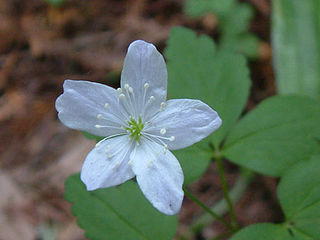
Anemonoides quinquefolia, a flowering plant in the buttercup family Ranunculaceae, is native to North America. It is commonly called wood anemone or windflower, not to be confused with Anemonoides nemorosa, a closely related European species also known by these common names. The specific epithet quinquefolia means "five-leaved", which is a misnomer since each leaf has just three leaflets. A plant typically has a single, small white flower with 5 sepals.

Staphylea, called bladdernuts, is a small genus of 10 or 11 species of flowering plants in the family Staphyleaceae, native to temperate regions of the Northern Hemisphere. The highest species diversity is in China, where four species occur.

Anemone hepatica, the common hepatica, liverwort, liverleaf, kidneywort, or pennywort, is a species of flowering plant in the buttercup family Ranunculaceae, native to woodland in temperate regions of the Northern Hemisphere. This herbaceous perennial grows from a rhizome.
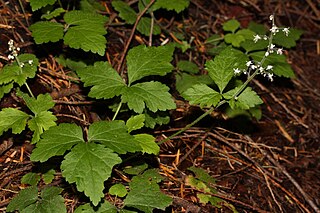
Tiarella trifoliata, the three-leaf foamflower, is a species of flowering plant in the family Saxifragaceae. The specific name trifoliata means "having three leaflets", a characteristic of two of the three recognized varieties. Also known as the laceflower or sugar-scoop, the species is found in shaded, moist woods in western North America.

Eriocapitella hupehensis, a species of flowering plant in the buttercup family Ranunculaceae, is native to Asia. The specific epithet hupehensis, which means "from Hupeh province, China", refers to a region where the species is known to occur. In Chinese, it is called dǎ pò wǎn huā huā (打破碗花花), which means "broken bowl flower".
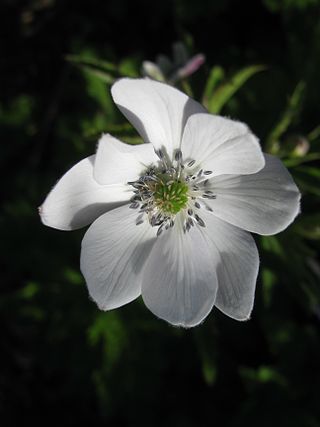
Eriocapitella rivularis, a species of flowering plant in the buttercup family Ranunculaceae, is native to Asia. The specific epithet rivularis means "waterside, of the rivers", which evidently refers to one of its preferred habitats. It is commonly called the riverside windflower. In Chinese, it is called cao yu mei, which means "grass jade plum".

Clintonia udensis is a species of flowering plant in the lily family Liliaceae. It is the only species of Clintonia native to Asia. It prefers sparsely forested habitat including the alpine forests of the Himalayas.
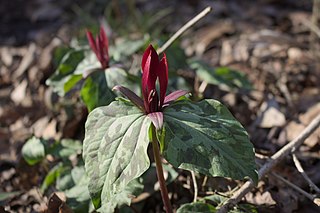
Trillium maculatum, the spotted wakerobin or spotted trillium, is a species of flowering plant in the family Melanthiaceae. It is a member of the Trillium cuneatum complex, a closely related group of sessile-flowered trilliums. The species is endemic to the southeastern United States, ranging across Alabama, Georgia, South Carolina, and northern Florida.

Anemone berlandieri, commonly known as tenpetal thimbleweed or tenpetal anemone, is a rhizomatous perennial flowering plant in the buttercup family Ranunculaceae. It is native to much of the Southern United States, where it flowers in the late winter and spring, between February and April. The specific epithet berlandieri honors Jean-Louis Berlandier (1803–1851), a botanist who explored Texas and Mexico in the nineteenth century.

Eriocapitella is a genus of flowering plants in the buttercup family Ranunculaceae. Plants of the genus are native to Asia. The generic name Eriocapitella roughly translates to "growing in a small woolly head", which refers to the hairy ovary and fruit of some members of the genus. Cultivated plants are commonly known as fall-blooming anemones.

Eriocapitella vitifolia, a species of flowering plant in the buttercup family Ranunculaceae, is native to Asia. The specific epithet vitifolia means "vine-leaved, with leaves resembling those of Vitis", the genus of grapevines, and so the plant is commonly called the grape-leaved anemone or grape-leaved windflower. In Chinese, a common name is ye mian hua, which means "wild cotton".

Eriocapitella tomentosa, a species of flowering plant in the buttercup family Ranunculaceae, is native to Asia. The specific epithet tomentosa means "thickly matted with hairs, tomentum (padding)". In Chinese, a common name is da huo cao (大火草), which means "big fire grass" or "great fireweed".

Eriocapitella japonica is a species of flowering plant in the buttercup family Ranunculaceae. The specific epithet japonica means "from Japan", which is a misnomer since the species is introduced in Japan. It is native to China, Taiwan, and Vietnam.
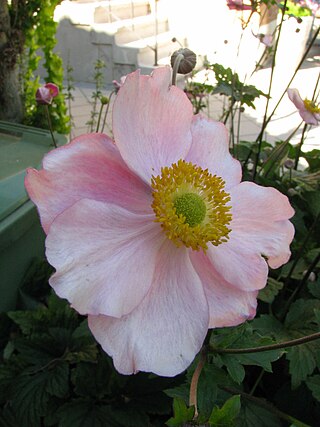
Eriocapitella × hybrida is a hybrid of flowering plants in the buttercup family Ranunculaceae. The parents of the hybrid are E. japonica and E. vitifolia. Cultivars of the hybrid are commonly known as Japanese anemone hybrids.

Distylium myricoides is a species in the genus Distylium in the family Hamamelidaceae. It is native to southern China.

Sycopsis is a genus of plants in the family Hamamelidaceae native to southern central China and Taiwan.

Tiarella polyphylla is a species of flowering plant in the family Saxifragaceae. The specific name polyphylla means "many-leaved". The species is native to Asia, ranging from the eastern Himalayas to China, east Asia, and southeast Asia. It is sometimes called the Asian foamflower.


















